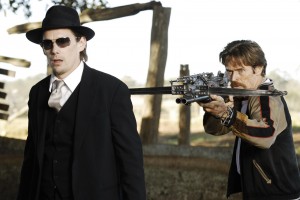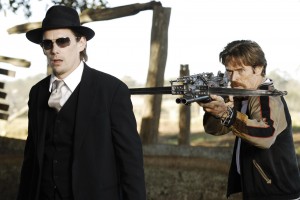DAYBREAKERS: 3 ½ STARS
 Like “True Blood” “Daybreakers” is set in a world where vampires live among humans, but unlike the popular HBO show these vampires don’t have a blood substitute to keep them alive and friendly. In fact, in the world created by the writer / director team of the Spierig Brothers (Michael and Peter) humans are on the verge of extinction having literally been sucked dry and now the vamps must come up with a new source of food to ensure their survival.
Like “True Blood” “Daybreakers” is set in a world where vampires live among humans, but unlike the popular HBO show these vampires don’t have a blood substitute to keep them alive and friendly. In fact, in the world created by the writer / director team of the Spierig Brothers (Michael and Peter) humans are on the verge of extinction having literally been sucked dry and now the vamps must come up with a new source of food to ensure their survival.
Hematologist Ethan Hawke is charged with creating the cure for vampire hunger by his bosses at Bromley Marks, the world’s leading blood handler and humans-as-food storage facility. Ethan can best be described as a reluctant vampire and knows that the “last breath of humanity in the vampires will disappear as soon as the blood does.” To that end he searches for a cure and when he meets a group of human rebels a different kind of solution to the problem may be at hand.
As has become popular on “True Blood” and in movies like “Twilight” in “Daybreakers” many old vampire myths have flown the coop. For example Ethan Hawke’s character smokes. Perhaps because he is eternal he doesn’t have to worry about lung cancer, but since he is already dead, were does he get the breath to inhale and exhale? You never saw Dracula with a smoke in his hand…
Luckily, when the movie isn’t playing fast and loose with vampire lore, it is an entertaining a vampire tale that plays up its b-movie thrills.
Ripe with cool lines—“Life’s a bitch,” says Hawke’s world weary vampire, “and then you don’t die”—cool new vampire mythology—vamps who feed on themselves become mutants—and cool ideas—blood becomes a commodity like oil—“Daybreakers” is the best night stalker film to come along since last year’s “Let the Right One In.” (Sorry Twi-Hards!)
Hawke, with his sunken cheeks and rough hewn good looks is well cast as Edward, the disinclined vampire, but his character becomes much more fun in the last half of the film (SPOILER ALERT) when he morphs into Ethan Hawke, Vampire Slayer.
The film, for all its effective spooky vampiric atmosphere in the first hour, builds towards a bloody climax that can only be described as juicy. People (and vampires) don’t just die as much as they explode, spraying a cloud of moist viscera in every direction. This is one movie I was glad wasn’t in 3-D.
“Daybreakers” doesn’t have enough bite to become a modern vampire classic like “Nosferatu the Vampyre” or “Let the Right One In,” it’s too down and dirty for that, but it is great b-movie fun in the tradition of “Innocent Blood” or “Near Dark.”

